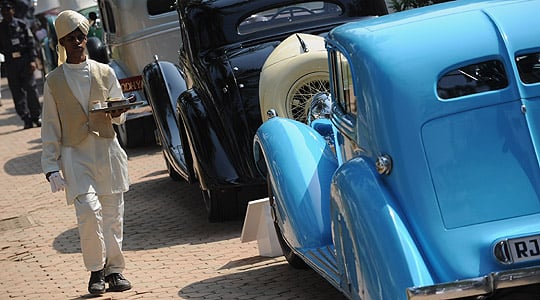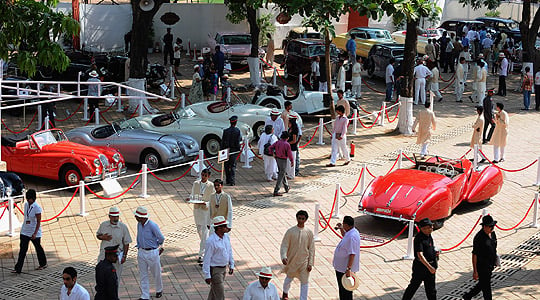
Atmosphere at the Cartier Travel with Style
No distance is too great for the intrepid correspondents of Classic Driver, so this week we’re bringing you the latest from Bombay (Mumbai to CNN viewers), where your scribe has just returned from judging the country’s first world-standard classic car concours d’elegance. And not just any concours, but the inaugural Travel with Style event hosted by a firm which knows a thing or two about style. Top society jeweller Cartier doesn’t do anything by halves, so I wasn’t expecting an invitation to any of the usual places but, when they announced they would be flying participants to India... Needless to say, it didn’t take me long to accept the invitation.
And what an event it turned out to be. From the moment our jet touched down in India’s largest city (population 20 million and growing), we were swept away by the dazzling colours, the faded colonial architecture overshadowed by the soaring modern structures, the magnificent temples, the scents ('exotic spices with a hint of carbon monoxide'), the warmth of the people and the climate, and, most of all, just the general buzz of life.

Fellow judges at this most exclusive of car gatherings included Nick Mason of Pink Floyd, Gordon Murray of McLaren Grand Prix fame, fellow designer Peter Stevens (who styled the F1 road car), Hong Kong collector Sir Michael Kadoorie, veteran war photographer Don McCullen, TV producer Mark Stewart (Sir Jackie’s son), cricketer-turned-politician Imran Khan, the ever glamorous model (and closet petrolhead) Yasmin Le Bon and Prince Michael of Kent, the dapper, car-racing cousin of Queen Elizabeth. Keeping the whole show on the road, and the man whose fertile imagination dreamed up the concept in the first place, was conservationist and traveller Mark Shand, brother of the HRH The Duchess of Cornwall. Your humble correspondent was in good company...
Wafted from the airport in a fleet of chauffeur-driven Mercedes, one of the first things that struck us in India was the driving style. Taxis, most of which appear to be based on 50-plus-year-old Fiat 1100s and none of which have a single undamaged panel, are not so much driven as piloted with a blind faith in fate (it’s perhaps no coincidence that re-incarnation is a popular local belief). I didn’t need to ask what the command ‘Honk Me’ adorning everyone’s rear bumper signified: no driver seems to let more than 10 seconds pass without leaning on his horn, which I learnt has various meanings ranging from ‘Watch out’ or ‘I’m passing you’ or ‘I’m about to hit you’ to simply ‘Hello’. Add to this maelstrom pedestrians who seem to be playing a game of chicken (a 10cm gap between you and cars passing at full speed is deemed plenty) and it’s a cross between gladiatorial sport and a Technicolor video game.

Prince Mavendra Singh of Barwani
Our first stop and base for the weekend was the Taj Palace, Bombay’s most famous hotel located right on the seafront but, slightly oddly, facing the city, not the Indian Ocean. It was commissioned in 1902 by a young, upcoming businessman named Mr Tata (yes, that Mr Tata), after he was refused entry as a non-white to another luxury hotel. Legend has it that the original European architect handed over the plans to local builders and informed them he would be back from Europe in six months to check on progress. His reaction upon finding they had built the hotel backwards was apparently to jump off the roof...

Mr and Mrs Jackie Shroff admire a Mercedes-Benz 500K
A short Mercedes ride later and Dashrat, our friendly driver in a crisp white uniform with hat and gloves to match, pulled up at the Royal West Indian Turf Club, where a red carpet stretched from the entrance into the heart of this most colonial of establishments, founded in 1880 and still the centre of horseracing in India. Among the many natural resources in which the country abounds, one is people, and I counted over 300 staff on hand to make sure entrants, guests and judges were looked after from the moment we set foot on Indian soil to the moment we left. Service in India is exemplary - it’s rather like stepping back in time to the era of Rudyard Kipling's novels, and never more so than when surrounded by 60 of the most opulent vintage cars which Prince Manvendra Singh, one of India’s leading motoring authorities, had pried out of largely hidden garages across the land, which have never been visited by outsiders. Many belonged to Maharajas and most had been in their families from new: they don’t really do ‘second-hand’. The vast majority were pre-War and most of these carried bespoke coachwork built to the order of their flamboyant and fabulously wealthy first owners.

Most curious of these, perhaps, was an open 1930s Rolls-Royce with cut-down bodywork and three rows of seats to transport the Maharaja’s cricket team. But there were also supercharged Mercedes of the 1920s, a magnificent Daimler Double Six (the 12-cylinder rarity) built for King George V’s planned visit in 1935 (he didn’t come but the car did) and a lovely streamlined Phantom II Continental with rakish coachwork by top London firm Gurney Nutting. After India gained its independence in 1947, the power and wealth of the ruling classes was dramatically curtailed but they were still able to enjoy a lavish lifestyle; hence a trio of handsome XK120 roadsters on display (all sold new in India) and even a Mercedes-Benz 300SL Roadster which, rather than leading the boulevardier life of its western contemporaries, was raced all over India by the prince who bought it new and still owns it.

Delahaye Best of Show winner with owner, Maharaj Duleep Singhji of Jodhpur
Most spectacular of all, though, and perhaps not surprisingly the winner of the Best of Show trophy, was a voluptuous 1939 Delahaye 135 Roadster bodied by those most extravagant of pre-War Parisian coachbuilders, Figoni & Falaschi. Shipped to Bombay in ’39 with an almost identical sister car by a Frenchman escaping the conflict in Europe, this sensational, aerodynamic showstopper remained in India when its owner left and has been in the same Maharaja’s family ever since: the current prince swapped it with his older brother in 1958... for a used Willys Jeep.

Simon Kidston explaining cars to Shah Rouk Khan and CEO of Cartier International, Bernard Fornas
The great and the good of Mumbai society were out in force: Cartier has been here since the 19th Century and an invitation from them carries weight. Top Bollywood names arrived with an entourage which would put Hollywood to shame, including megastar Shah Rouk Khan (India’s answer to Brad Pitt) and action hero Jacky Shroff (think James Bond meets Rambo), who entered his SS100 Jaguar, another car shipped new to India. But, if you’re a Western collector expecting a sudden influx of Indian buyers, you’ll need to be patient: not only are exports of historic cars banned from India, but they can’t be imported either. Yet.
India is a world away from the tranquil settings where vintage car events are usually played out, but it felt absolutely ‘right’ - somehow the slightly surreal ambience perfectly complemented the equally surreal cars, certainly not restored in the way the Europeans or Americans are used to seeing them, but all the more fascinating for it. I can’t wait to return.
Note: Watch out for ‘The Maharaja’s Motor Car: The Story of Rolls-Royce in India’, a documentary produced by Mark Stewart featuring many of India’s hidden motoring treasures, due to be broadcast by the BBC in the spring.
Text - Simon Kidston
Photos - Kidston SA / Cartier
ClassicInside - The Classic Driver Newsletter
Free Subscription!


